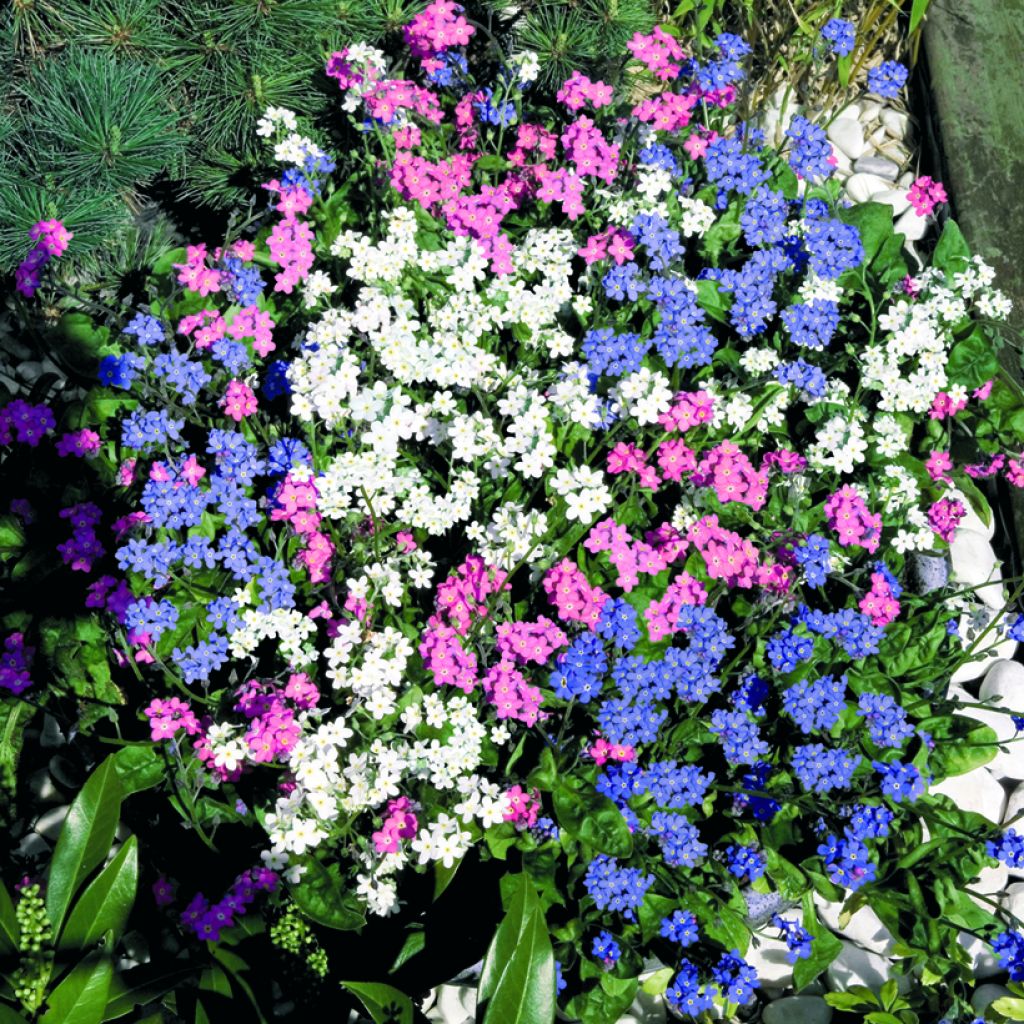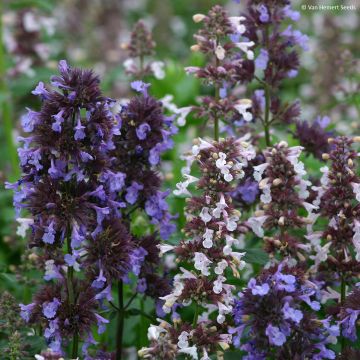

Myosotis sylvatica Sylva Mix seeds - Wood Forget-Me-Not
Myosotis sylvatica Sylva Mix seeds - Wood Forget-Me-Not
Myosotis sylvatica Sylva Mix
Wood Forget-Me-Not, Forget-Me-Not
This item cannot be shipped to the selected country
Dispatch by letter from €3.90
More information
Schedule delivery date,
and select date in basket
This plant carries a 6 months recovery warranty
More information
We guarantee the quality of our plants for a full growing cycle, and will replace at our expense any plant that fails to recover under normal climatic and planting conditions.
Seed-only orders are dispatched by sealed envelope. The delivery charge for seed-only orders is €3.90.
Does this plant fit my garden?
Set up your Plantfit profile →
Description
Myosotis sylvatica 'Sylva Mix' is a colourful mix of wood or forest forget-me-nots. It is generous with its delightful little flowers, well-known in all possible colours: white, pink, and of course blue. This annual or short-lived perennial roams the garden and forms bright carpets at the base of bulbs, bushes, and perennials. This plant self-seeds reliably over the years. It shows a preference for a rather moist, fertile, and well-drained soil, in the partial shade of woodlands, or in sunny borders and rockeries.
The wood forget-me-not is a plant from the borage family, native to meadows, clearings, and forest edges across almost all of Europe, except for the far north and southwest. This short-lived perennial plant, typically grown as an annual, forms small rosettes of hairy, pale green foliage from which hairy stems emerge from April to June, branching out in their upper part, bearing up to 30 cm high curved inflorescences that lengthen as the flowers bloom. They are composed of bright lavender blue, soft pink, or white fragrant flowers with a yellow heart, 5 mm in diameter. Once well established, the wood forget-me-not self-seeds abundantly in the garden.
Myosotis sylvatica 'Sylva Mix', an annual or short-lived perennial, is particularly appreciated in spring when its flowers appear. It spreads spontaneously in the garden, creating bright carpets at the base of bulbs, bushes, and other perennials. Enjoying our climates, it self-seeds, blending into the landscape over the years, almost timeless. It prefers moist, fertile, and well-drained soils, thriving equally well in the gentle shade of woodlands as in sunny borders and rockeries. Mix 'Sylva Mix' in a variety of colours with spring bulbs and flowers like Daffodils, narcissi, primroses, dwarf irises, or tulips to complement their blooms.
Report an error about the product description
Flowering
Foliage
Plant habit
Botanical data
Myosotis
sylvatica
Sylva Mix
Boraginaceae
Wood Forget-Me-Not, Forget-Me-Not
Northern Europe
Other Forget-me-Not seeds
Planting and care
Sow the Myosotis Sylva Mix from May to June. Place the seeds on the surface of moist, light and well-drained soil. Do not cover the seeds. Enclose in a polythene bag maintained at 15 to 20ºC. Germination usually takes 14 to 30 days. Do not exclude light, as it facilitates germination. Seeds can also be sown directly outside, 6mm deep, in rows spaced 30cm apart. Thin to 23cm apart. Transplant the plants when they are large enough into individual pots. Let them grow in cooler conditions for 10 to 15 days before transplanting them when the risk of frost has passed, spacing them 15cm apart. September sowings can overwinter in a cool place and be transplanted outdoors in spring. Wood forget-me-not thrives in any ordinary, well-drained soil, in partial shade or dappled sunlight.
Sowing period
Intended location
This item has not been reviewed yet - be the first to leave a review about it.
Flower seeds
Haven't found what you were looking for?
Hardiness is the lowest winter temperature a plant can endure without suffering serious damage or even dying. However, hardiness is affected by location (a sheltered area, such as a patio), protection (winter cover) and soil type (hardiness is improved by well-drained soil).

Photo Sharing Terms & Conditions
In order to encourage gardeners to interact and share their experiences, Promesse de fleurs offers various media enabling content to be uploaded onto its Site - in particular via the ‘Photo sharing’ module.
The User agrees to refrain from:
- Posting any content that is illegal, prejudicial, insulting, racist, inciteful to hatred, revisionist, contrary to public decency, that infringes on privacy or on the privacy rights of third parties, in particular the publicity rights of persons and goods, intellectual property rights, or the right to privacy.
- Submitting content on behalf of a third party;
- Impersonate the identity of a third party and/or publish any personal information about a third party;
In general, the User undertakes to refrain from any unethical behaviour.
All Content (in particular text, comments, files, images, photos, videos, creative works, etc.), which may be subject to property or intellectual property rights, image or other private rights, shall remain the property of the User, subject to the limited rights granted by the terms of the licence granted by Promesse de fleurs as stated below. Users are at liberty to publish or not to publish such Content on the Site, notably via the ‘Photo Sharing’ facility, and accept that this Content shall be made public and freely accessible, notably on the Internet.
Users further acknowledge, undertake to have ,and guarantee that they hold all necessary rights and permissions to publish such material on the Site, in particular with regard to the legislation in force pertaining to any privacy, property, intellectual property, image, or contractual rights, or rights of any other nature. By publishing such Content on the Site, Users acknowledge accepting full liability as publishers of the Content within the meaning of the law, and grant Promesse de fleurs, free of charge, an inclusive, worldwide licence for the said Content for the entire duration of its publication, including all reproduction, representation, up/downloading, displaying, performing, transmission, and storage rights.
Users also grant permission for their name to be linked to the Content and accept that this link may not always be made available.
By engaging in posting material, Users consent to their Content becoming automatically accessible on the Internet, in particular on other sites and/or blogs and/or web pages of the Promesse de fleurs site, including in particular social pages and the Promesse de fleurs catalogue.
Users may secure the removal of entrusted content free of charge by issuing a simple request via our contact form.
The flowering period indicated on our website applies to countries and regions located in USDA zone 8 (France, the United Kingdom, Ireland, the Netherlands, etc.)
It will vary according to where you live:
- In zones 9 to 10 (Italy, Spain, Greece, etc.), flowering will occur about 2 to 4 weeks earlier.
- In zones 6 to 7 (Germany, Poland, Slovenia, and lower mountainous regions), flowering will be delayed by 2 to 3 weeks.
- In zone 5 (Central Europe, Scandinavia), blooming will be delayed by 3 to 5 weeks.
In temperate climates, pruning of spring-flowering shrubs (forsythia, spireas, etc.) should be done just after flowering.
Pruning of summer-flowering shrubs (Indian Lilac, Perovskia, etc.) can be done in winter or spring.
In cold regions as well as with frost-sensitive plants, avoid pruning too early when severe frosts may still occur.
The planting period indicated on our website applies to countries and regions located in USDA zone 8 (France, United Kingdom, Ireland, Netherlands).
It will vary according to where you live:
- In Mediterranean zones (Marseille, Madrid, Milan, etc.), autumn and winter are the best planting periods.
- In continental zones (Strasbourg, Munich, Vienna, etc.), delay planting by 2 to 3 weeks in spring and bring it forward by 2 to 4 weeks in autumn.
- In mountainous regions (the Alps, Pyrenees, Carpathians, etc.), it is best to plant in late spring (May-June) or late summer (August-September).
The harvesting period indicated on our website applies to countries and regions in USDA zone 8 (France, England, Ireland, the Netherlands).
In colder areas (Scandinavia, Poland, Austria...) fruit and vegetable harvests are likely to be delayed by 3-4 weeks.
In warmer areas (Italy, Spain, Greece, etc.), harvesting will probably take place earlier, depending on weather conditions.
The sowing periods indicated on our website apply to countries and regions within USDA Zone 8 (France, UK, Ireland, Netherlands).
In colder areas (Scandinavia, Poland, Austria...), delay any outdoor sowing by 3-4 weeks, or sow under glass.
In warmer climes (Italy, Spain, Greece, etc.), bring outdoor sowing forward by a few weeks.




















































